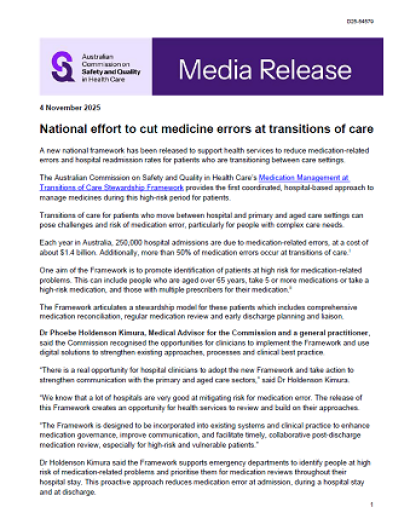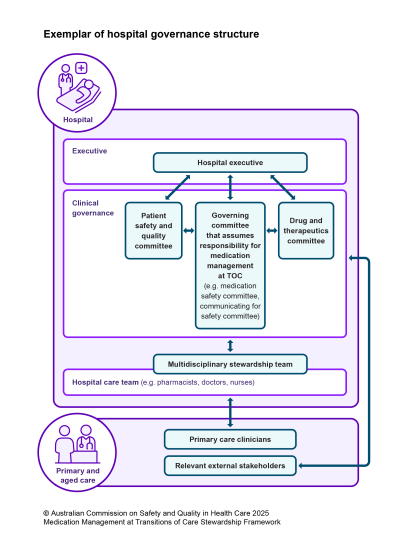A new national framework has been released to support health services to reduce medication-related errors and hospital readmission rates for patients who are transitioning between care settings.
The Australian Commission on Safety and Quality in Health Care’s Medication Management at Transitions of Care Stewardship Framework provides the first coordinated, hospital-based approach to manage medicines during this high-risk period for patients.
Transitions of care for patients who move between hospital and primary and aged care settings can pose challenges and risk of medication error, particularly for people with complex care needs.
Each year in Australia, 250,000 hospital admissions are due to medication-related errors, at a cost of about $1.4 billion. Additionally, more than 50% of medication errors occur at transitions of care.[i]
One aim of the Framework is to promote identification of patients at high risk for medication-related problems. This can include people who are aged over 65 years, take 5 or more medications or take a high-risk medication, and those with multiple prescribers for their medication.[ii]
The Framework articulates a stewardship model for these patients which includes comprehensive medication reconciliation, regular medication review and early discharge planning and liaison.
Dr Phoebe Holdenson Kimura, Medical Advisor for the Commission and a general practitioner, said the Commission recognised the opportunities for clinicians to implement the Framework and use digital solutions to strengthen existing approaches, processes and clinical best practice.
“There is a real opportunity for hospital clinicians to adopt the new Framework and take action to strengthen communication with the primary and aged care sectors,” said Dr Holdenson Kimura.
“We know that a lot of hospitals are very good at mitigating risk for medication error. The release of this Framework creates an opportunity for health services to review and build on their approaches.
“The Framework is designed to be incorporated into existing systems and clinical practice to enhance medication governance, improve communication, and facilitate timely, collaborative post-discharge medication review, especially for high-risk and vulnerable patients.”
Dr Holdenson Kimura said the Framework supports emergency departments to identify people at high risk of medication-related problems and prioritise them for medication reviews throughout their hospital stay. This proactive approach reduces medication error at admission, during a hospital stay and at discharge.
“At our clinic, we always welcome a phone call to the GP or practice nurse from the treating team before a patient is discharged back into our care. This allows a conversation where significant medication changes can be identified, and I see the patient within days of their discharge to reduce risk of medication-related harm,” she said.
Individuals with one or more medicines missing from their discharge information are far more likely to be readmitted to hospital than those with correct information at discharge.
Many clinicians have experienced first-hand the success of the antimicrobial stewardship model in hospitals, which supports the judicious use of antimicrobials, according to Dr Holdenson Kimura.
“It would be fantastic to see the adoption and implementation of this medication management stewardship model embedded in Australian hospitals – similar to the antimicrobial and opioid stewardship models – to improve patient care,” she said.
Digital tools are key to reach potential of the Framework
Health services are encouraged to adopt safe, high-quality digital tools to strengthen communication between clinicians across settings and improve medication management at transitions of care.
“Digital enablement will be key to realising the full potential of the Framework – but these digital tools need to be interoperable to enable accurate and timely communication,” said Dr Holdenson Kimura.
“Within the hospital setting, the digital system needs to be seamless and easily accessed by different members of the care team. This would mean that prescribing software and pharmacy dispensing software is working well together to support discharge.
“To streamline communication about medication use across settings, standardised electronic discharge summaries would be delivered automatically and securely at the time of discharge, and uploaded to the patient’s electronic health record, such as My Health Record,” she added.
The Framework was developed as part of the Commission’s leadership on Australia’s response to the World Health Organization Global Patient Safety Challenge: Medication without Harm. This challenge was focused on reducing severe, avoidable medication-related harm by 50% over the five years to 2024 with an emphasis on high-risk medicines, polypharmacy and transitions of care.
More information: safetyandquality.gov.au/mmtoc


